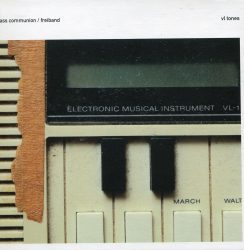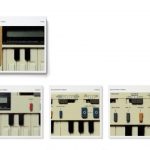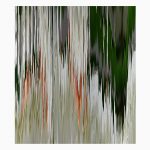BASS COMMUNION / FREIBAND – VL TONES
Mentioning the Casio VL-Tone VL1 synth brings back fond memories (but more on that later). So when I read about this collaboration project by Frans ‘Freiband’ de Waard and Steven ‘Bass Communion’ Wilson, it was a no-brainer for me. I was curious to hear what these two wizards would be able to make from the limited sound set of this early Casio.
The idea of this project started when Frans de Waard was invited to create an album of one-minute pieces using only the sounds of the VL-Tone 1. Each of these pieces was to be a collaboration with artists Frans has worked with before; one of them being Steven Wilson. This particular set of one-minute pieces is still to be released, but Frans and Steven continued to work on the source material, “each processing what the other would send, using both digital and analogue technology.”
Before long, there was a wealth of material: a selection was made to fill two CD’s plus a third with pieces that didn’t make the selection but were still interesting enough to include in the box set.
And a beautiful set it is: three CD’s, each in a sleeve with photo’s of a (well-used) VL-Tone, completed with a poster including the complete email-exchange of the artists while working on the project.
The 24 tracks explore a wide range of styles: “from dark ambient to musique concrete collage-style pieces, from rhythmic to drone-ambient, from brief interludes to lengthy journeys.” Of course, the four original short pieces that ignited this project are also included. The pieces range in length from 1:15 to 32:23, each exploring its own universe.
I have a personal history with the VL-Tone: in my youth, I desperately wanted to own a synthesizer but never could afford one. So when the Casio came out, I immediately bought one – only found out that my creative capabilities were too limited to do anything useful with it. So the synth soon became a toy for my kids, who enjoyed it very much. They especially enjoyed hitting the ‘Demo’ button continuously so I saw no other option than sabotaging that button. But the sounds and rhythms (remember Trio’s ‘Da Da Da’?) of the VL-Tone became part of hour family history this way.
You’ll have to dive very deep into these tracks to recognize the VL-Tone sounds, even though “the only sound sources allowed were the original VL Tone recordings”. The original samples were “twisted, reshaped, and reprocessed beyond all recognition” into a full-fledged collection of electronic experimental music that exceeds the limited scope of the original instrument by far. There were a few moments when I recognized a sample, but I doubt I would have associated the music with the VL-Tone is I had heard it without context and without the images.
And in fact, that’s the beauty of this project. Define a set of rules, limit your sources and then experiment and see where it leads to. And in this case, it leads to a fascinating document, a tribute to the earliest affordable synthesizers, and three hours of great music.
BASS COMMUNION / FREIBAND – BC HYBRID MIX
OK, OK. Since you don’t insist: here’s a link to the original demo tune from the VL-Tone.
Remember it’s totally unrelated (apart from the synth itself) to the Bass Communion/Freiband box set. But you’ll have to admit it ís an annoying earworm showing off what one cóuld do with the VL-Tone with the appropriate skills and a lot of patience.
BEN VIDA – REDUCING THE TEMPO TO ZERO
I have a weakness for the USB-credit card format. It brings its own challenge to create a design for the card as well as its package, it satisfies the tactile need to hold a product in the hand (as opposed to digital-only), it can be shipped múch cheaper than a vinyl album or even a CD. And, most important: it can hold much more music in the highest digital quality. As most modern systems also feature a USB connector, you don’t need to carry around a computer anymore to be able to play it on a decent system.
On Reducing The Tempo To Zero, Ben Vida presents a four-hour piece in four parts of approximately one hour each (which, of course, can also be played separately). As the title suggests, this is the most minimal of minimalist music: durational drones in the tradition of composers like Morton Feldman, La Monte Young, and Eliane Radigue.
“It strives to unravel the standards and expectations applied to musical and experiential time, taking the relation to sonic phenomena into an almost transcendental realm. Immersive in scale and endurance, [with] a deep and radical sensitivity to material and structural hybridity.”
Which does not mean the dronescapes continue endlessly for the full four hours: there are quite radical changes in the sound field (such as around 18″ in the first hour), which suggest that this is not meant to be one continuous piece but a set of contemplative works that also could’ve been divided into single pieces.
Reducing The Tempo To Zero is conceived “as a part of a daily practice which embarked upon sustained periods of focused creation and listening.”
And perhaps that is also what it asks from the listener: let go of your rushed daily routine and immerse yourself into a soundworld that is “overwhelmingly beautiful in its oscillating harmonics and punctuation of pulsing texture and tone, each stage of its evolution moving at a glacial pace.”
The title, Reducing The Tempo To Zero, can be read as a description of the music, but also as an instruction to the listener.
Reduce your own personal tempo to zero for maximum effect.




